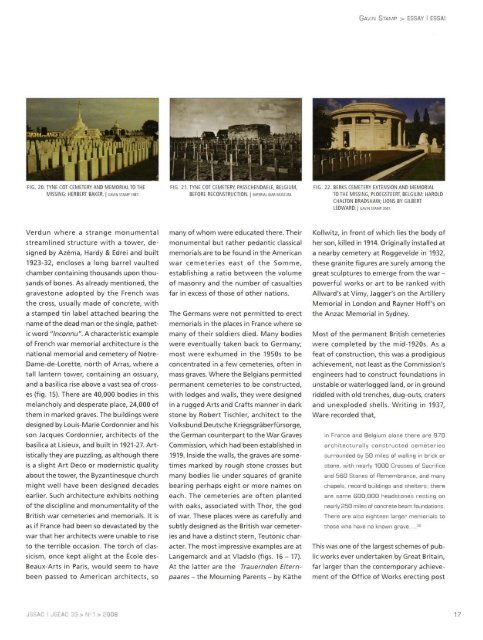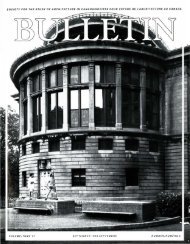CANADA - SEXTONdigital
CANADA - SEXTONdigital
CANADA - SEXTONdigital
Create successful ePaper yourself
Turn your PDF publications into a flip-book with our unique Google optimized e-Paper software.
G AV IN S TAM P > ESS AY I ESSAI<br />
FIG. 20. TYNE COT CEMETERY AN D MEMORIAL TO THE<br />
MISSING: HERBERT BAKER. I GAVIN STAMP 1987.<br />
FIG . 21. TYNE COT CEM ETERY, PASSCHENDAELE, BELGIUM,<br />
BEFORE RECONSTRUCTION. ! IMPERIAL WAR MUSEU M.<br />
FIG. 22. BERKS CEMETERY EXTENSION AN D MEMORIAL<br />
TO THE MISSIN G, PLOE GS TEERT, BELGIUM: HAROLD<br />
CHA LTON BRADSHAW; LIONS BY GI LBERT<br />
LED WARD. I GAVIN STAMP 2007.<br />
Verdun where a strange monumental<br />
streamlined structure with a tower, designed<br />
by Azema, Hardy & Edrei and built<br />
1923-32, encloses a long barrel vaulted<br />
chamber containing thousands upon thousands<br />
of bones. As already mentioned, the<br />
gravestone adopted by the French was<br />
the cross, usually made of concrete, with<br />
a stamped tin label attached bearing the<br />
name ofthe dead man or the single, pathetic<br />
w ord "lnconnu". A characteristic example<br />
of French war memorial architecture is the<br />
national memorial and cemetery of Notre<br />
Dame-de-Lorette, north of Arras, where a<br />
tall lantern tower, containing an ossuary,<br />
and a basilica rise above a vast sea of crosses<br />
(fig. 15). There are 40,000 bodies in this<br />
melancholy and desperate place, 24, 000 of<br />
them in marked graves. The buildings were<br />
designed by Louis-Marie Cordonnier and his<br />
son Jacques Cordonnier, architects of the<br />
basilica at Li sieu x, and built in 1921-27. Artistica<br />
lly they are puzzling, as although there<br />
is a slight Art Deco or modernistic quality<br />
about the tower, the Byzantinesque church<br />
might well have been designed deca des<br />
earlier. Such architecture exhibits nothing<br />
of the discipline and monumentality of the<br />
British war cemeteries and memorials. It is<br />
as if France had been so devastated by the<br />
war that her architects were unable to rise<br />
to the terrible occasion. The torch of classicism,<br />
once kept alight at the Ecole des<br />
Beaux-Arts in Paris, w ould seem to have<br />
been passed to American architects, so<br />
many of whom were educated there. Their<br />
monumental but rather pedantic classical<br />
memorials are to be found in the American<br />
war cemeteries east of the Somme,<br />
establishing a ratio between the volume<br />
of masonry and the number of casualties<br />
far in excess of those of other nations.<br />
The Germans were not permitted to erect<br />
memorials in the places in France w here so<br />
many of their soldiers died. Many bodies<br />
were eventually taken back to Germany;<br />
most were exhumed in the 1950s to be<br />
concentrated in a few cemeteries, often in<br />
mass graves. Where the Belgians permitted<br />
permanent cemeteries to be constructed,<br />
w ith lodges and walls, they were designed<br />
in a rugged Arts and Crafts manner in dark<br />
stone by Robert Tischler, architect to the<br />
Volksbund Deutsche KriegsgraberfUrsorge,<br />
the German counterpart to the War Graves<br />
Commission, which had been established in<br />
1919. Inside the walls, the graves are somet<br />
imes marked by rough stone crosses but<br />
many bodies lie under squares of granite<br />
bearing perhaps eight or more names on<br />
each . The cemeteries are often planted<br />
w ith oaks, associated with Thor, the god<br />
of war. These places were as carefully and<br />
subtly designed as the British w ar cemeter-<br />
ies and have a distinct stern, Teutonic char-<br />
acter. The most impressive examples are at<br />
Langemarck and at Vladslo (figs. 16- 17).<br />
At the latter are the Trauernden Elternpaares<br />
- the Mourning Parents - by Kathe<br />
Kollwitz, in front of which lies the body of<br />
her son, killed in 1914. Originally installed at<br />
a nearby cemetery at Roggevelde in 1932,<br />
these granite figures are surely among the<br />
great scu lptures to emerge from the warpowerful<br />
works or art to be ranked with<br />
Allward's at Vimy, Jagger's on the Artillery<br />
Memorial in London and Rayner Hoff's on<br />
the Anzac Memorial in Sydney.<br />
Most of the permanent British cemeteries<br />
were completed by the mid-1920s. As a<br />
feat of construction, this was a prodigious<br />
achievement, not least as the Commission 's<br />
engineers had to construct foundations in<br />
unstable or waterlogged land, or in ground<br />
riddled with old trenches, dug-outs, crate rs<br />
and unexploded shells. Writing in 1937,<br />
Ware recorded that,<br />
in F1·ance and Belgium al one there are 970<br />
architectu1· ally c on struct ed cemeteries<br />
surrounded by 50 miles of walling in b1·ick or<br />
stone, with nearly 1000 Crosses of Sacrifice<br />
and 560 Stones of Remembrance, and many<br />
chapels , record buildings and shelters; there<br />
a1· e some 600,000 headstones resting on<br />
nea1·ly 250 miles of concrete beam foundations.<br />
There are al so eighteen la1·ger memorials to<br />
those who have no known grave.<br />
30<br />
This w as one of the largest schemes of public<br />
w orks ever undertaken by Great Britain,<br />
far larger than the contemporary achievement<br />
of the Office of Works erecting post<br />
JSSAC I JSEAC 33 > N' ·J > 2 008<br />
17
















